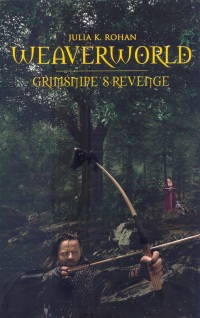| ________________
CM . . .
. Volume XIX Number 6 . . . . October 12, 2012
excerpt:
Julia K. Rohan’s novel, Grimsnipe’s Revenge, is an entertaining fantasy novel that resists some conventions of children’s literature. The story centres on 11-year-old Jack Fisher who accidentally goes through a portal in the real world to arrive at Weaverworld, a fantastic place where inhabitants use the power of imagination to weave things into existence with their minds. While in Weaverworld, Jack is mentored by an old archer and gets caught up in the fight against the evil Grimsnipe who wants to destroy the Weaver way of life. Although it may take a while for the reader to overcome some issues in the story, eventually the adventure captures the reader and carries the novel. What makes the novel hard to pin down is the result of some confusing choices in the plot and narration. One such area of confusion is the intended audience. On one hand, the point of view of the narration and the 11-year-old protagonist start the novel off with a very immature perspective that makes the novel seem aimed at entertaining children Jack’s age or younger. However, the novel is over 350 pages long and often seems plodding, especially at the beginning, so readers are not easily captivated. Furthermore, the diction used by the narrator is often well beyond what you would expect a child of 11 or younger to know. For example, in the first twenty pages, there are passages that include “sociopathic horse-play,” “highly stylized rolling-eyed look of exasperation,” and a dog “stationed like a sentry on the floor next to her waiting for edible fallout.” While it may work to expand the vocabulary of young readers, it also might discourage them early on. Other issues are with the accuracy in the story development. Jack decides to stay in Weaverworld because, in the real world, he has failed his exams and has to go to summer school. While this would make sense if Jack was in secondary school, it is not very believable for a child in Grade 4. Jack is from the fictional town of Boxton Pond somewhere in North America, and while that town may have exams for young children and require summer school, this does not fit with the reality of most elementary school children. This mistake in the “real world” of the novel may make it difficult for readers to suspend belief and buy into it. Apart from age-related content, there are also some cringe-worthy moments that may offend some readers, especially in the stereotypical portrayals of Aboriginal people. For instance, the Weaverworld girl Dorothy adores “stories about the Indians of North America.” At school she performs her own adaptation of Pocahontas and is always dressed in stereotypical Aboriginal costumes, such as “an Indian-style headband above a pair of long black braids”. There is nothing in the story to combat this stereotype or push back against it. Although heavily flawed, Weaverworld is a vivid fantasy land, and the characters who inhabit it are interesting. If readers persevere long enough, they may become caught up in a fun adventure story. Recommended with reservations. Beth Wilcox, who has her MA in Children’s Literature from the University of British Columbia, is currently teaching in Prince George, BC.
To comment on this
title or this review, send mail to cm@umanitoba.ca.
Copyright © the Manitoba Library Association. Reproduction for personal
use is permitted only if this copyright notice is maintained. Any
other reproduction is prohibited without permission.
NEXT REVIEW |
TABLE OF CONTENTS FOR THIS ISSUE
- October 12, 2012.
AUTHORS
| TITLES | MEDIA REVIEWS
| PROFILES
| BACK ISSUES
| SEARCH | CMARCHIVE
| HOME |
